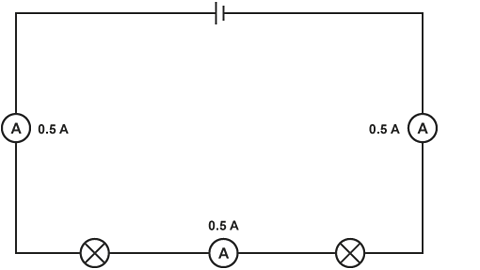Key points
Objects can become positively charged or negatively charged, usually because of friction between insulatorA material that does not allow current to flow through it easily, eg wood or glass. . This is called static electricity.
Charged objects exert electrostatic forces on each other. These can be attractive forces or repulsive forces.
Charged objects can attract neutral objects, due to the polarisation of chargeWhen charges move or separate in a neutral object, leaving areas of net positive or negative charge..
Video - Static electricity
Sometimes when you touch something metal, you can get a little electric shock, even if it’s not connected to a power source. And it’s all because of static electricity.
Static electricity is a build up of electric charge on an object, and it can have some pretty strange effects.
See, everything around us is made up of atoms which have a positively charged nucleus surrounded by negatively charged electrons. Normally, the positive and negative charges cancel out because there are the same number of each. So the atom has no overall charge - it is neutral.
But when you rub one, neutral, electrically insulating object against another, some of the electrons are transferred across, leaving an excess of negative charge on one of the objects, and a deficit on the other.
The combination of charges in nearby objects can create attractive or repulsive forces. These are non-contact forces, so the objects don’t need to touch.
Opposite charges will attract.
And like charges will repel.
When I rub this balloon on a jumper, it becomes negatively charged. Holding it near this uncharged wall, it repels the electrons near the surface, leaving a slight positive charge, which allows it to stick.
This Van de Graaff generator helps to build up electrical charge so we can see its effects. Electrons are picked up by the rubber belt and transferred into this conductive metal dome, and anything that’s touching it. Like these aluminium pie cases from my recycling bin!
Negative charge flowing into the pie cases causes them to repel one another. But without any way for the charge to escape, it builds up in the dome.
You can discharge a charged object by giving it a way to drain its electrons into the ground, like via this conductive rod.
There it goes! A spark forms as the electrons jump across the gap. And that’s why you sometimes get a static electric shock.
Can you answer these questions based on the video?
What is static electricity?
What happens when you rub one neutral , electrically insulating object against another?
Static electricity is a build-up of electrical charge on an object.
Some of the electrons are transferred across. This leaves an excess of negative charge on one of the objects, and a deficit on the other.
Effects of static electricity
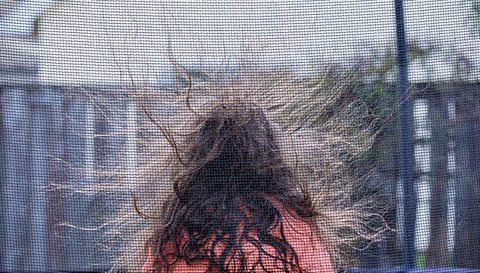
An electric shock can happen when a person approaches a metal object or another person. This is caused by static electricityA build-up of electrical charge on an object, which can be either positive or negative..
As well as creating sparks, static electricity can cause other interesting effects like making a balloon stick to a wall or attracting hair. electrostatic forceA force between two electrically charged objects. These forces can be attractive or repulsive. can cause objects to levitate.
Have a look at the Electrostatic sparks and shocks guide to find out more.

Experiments to try at home
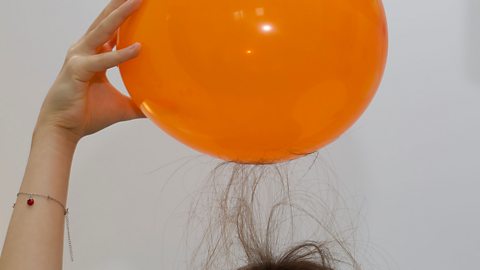
Experiment 1
Step 1- Rub a balloon on your hair. Your hair will become positively charged and the balloon will become negatively charged.
Step 2- Bring the balloon close to your hair and then move it away. You should find your hair and the balloon are attracted.

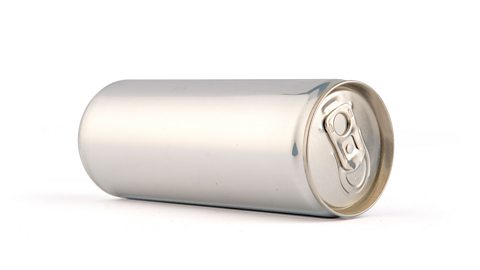
Experiment 2
Step 1 - Place an empty tin or can on its side on a table, so it can roll freely.
Step 2- Rub a balloon on your hair or jumper, to charge it.
Step 3 - Bring the balloon close to the can. It should attract the can.

Charging insulators by friction
There are two types of electrical charge:
positive (+)
negative (-)
Most objects contain equal amounts of positive and negative charges, so they are uncharged or neutral.
Negative charges, known as electrons, can be transferred by friction between insulators. Insulators do not conduct electricity.
When two different insulators are rubbed together, electrons move from one insulator to the other.
The object which gains electrons is now negatively chargedAn object which contains more negative charges than positive charges. Objects usually become negatively charged when they gain electrons (negative charges).. The object which loses electrons is now positively chargedAn object with more positive charges than negative charges. Objects usually become positively charged when they lose electrons (negative charges)..
Have a look through the slide show below to understand more about charging insulators by friction.
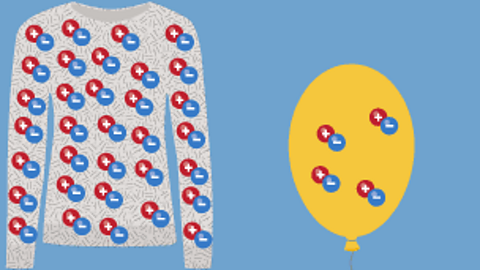
Image caption, 1. Jumper and balloon as neutral insulators
The jumper and the balloon are both neutral (uncharged) insulators. They contain equal numbers of positive and negative charges.
Image caption, 2. Insulators being charged by friction
The balloon is rubbed against the jumper. The friction causes electrons to be transferred.
Image caption, 3. Positively and negatively charged insulators
Both insulators are now charged. The jumper is positively charged because it has lost electrons. The balloon is negatively charged because it has gained electrons.
1 of 3
Structure of the atom
To understand why it is the negative charges which are transferred, it is helpful to look at the structure of the atom.
The electrons (negative charges) orbit near the edge of the atom. If the outer electrons have enough energy, they can escape from the atom and be transferred to other objects.
The protons (positive charges) are tightly bound in the nucleus of the atom, so they cannot easily escape.
When an electron escapes from an atom, the atom is no longer neutral because it now has more positive charge than negative charge. We call these charged atoms 'positive ions'.
Negative charges usually move between the insulators when they are rubbed together.
The electrons have a low mass and can escape from the atom easily, so they are mobile.
The positive ions have a much greater mass than the electrons, so it is more difficult for these positive charges to move.
Electrostatic forces
Electrostatic forces between charged objects can cause the objects to attract and repel.
Objects with like charges (both positive or both negative) will repel.
Objects with unlike charges (one is positive and the other is negative) will attract.
Think about the example of rubbing a balloon on a jumper.
The balloon gains electrons and becomes negatively charged.
The jumper loses electrons and becomes positively charged.
Because these objects have opposite charges, there is an attractive force and the balloon and the jumper are attracted to each other.
If two insulators have like charges (the same type of charge), then there is a repulsive force between them.
These balloons are both negatively charged, so they repel each other.
Polarisation of electrical charge
neutralAn object which contains equal numbers of positive and negative charges. This is the same as uncharged. objects are sometimes attracted by electrostatic forceA force between two electrically charged objects. These forces can be attractive or repulsive. too.
A charged balloon can stick to a wall, attract a drink can, or deflect a stream of water, even though only the balloon has been electrically charged.
This happens because of a process called polarisation of chargeWhen charges move or separate in a neutral object, leaving areas of net positive or negative charge.. Since electrons (small, light, negative charges) are mobile, they can move quite easily.
Note that:
positive ions are much more difficult to move
when a charged object, like a balloon, is moved close to a neutral object, for example a wall, the electrons are repelled and move further into the object
this leaves an area of net positive charge on the surface, even though the object is electrically neutral overall
Experiments to try at home
Try these experiments to see some examples of neutral objects being attracted by charged objects. All the experiments involve polarisation of charge.
Experiment 1
Step 1 - Charge a balloon, by rubbing it on your hair or clothing.
Step 2 - Move the rubbed part of the balloon close to a wall. The balloon should be attracted to the neutral wall and stick to it.
Experiment 2
Step 1 - Open a tap very slightly so there is only a thin, gentle stream of water coming from it.
Step 2- Charge a balloon, by rubbing it on your hair or clothing.
Step 3 - Move the balloon close to the stream of water. The water should be attracted towards the charged balloon, so that the stream of water is deflected.
Experiment 3
Step 1- Tear up a sheet of paper into small pieces.
Step 2 - Run a comb through your hair to charge it.
Step 3 - Move the comb close to the pieces of paper. The paper should be attracted to the comb.
Test your knowledge
Quiz
Teaching resources
Looking for more teaching resources to support your lessons on KS3 physics? Head to the 91Čȱ¬ Teach website for free, curriculum-linked resources to help deliver lessons - all arranged by subject and age group.
Play the Atomic Labs game! gamePlay the Atomic Labs game!
Try out practical experiments in this KS3 science game.

More on Electricity
Find out more by working through a topic
- count4 of 11
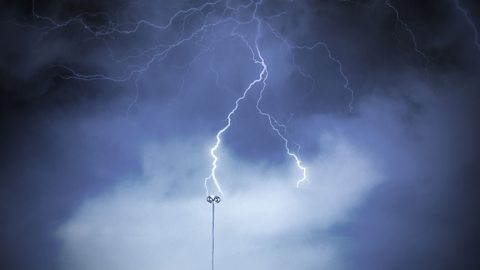
- count5 of 11
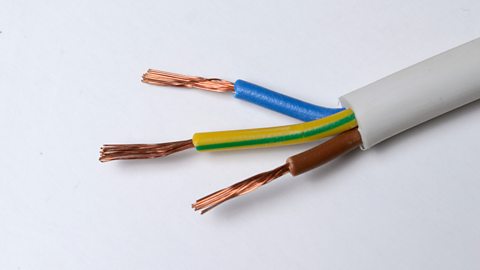
- count6 of 11
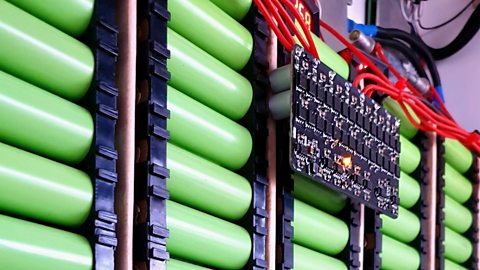
- count7 of 11
